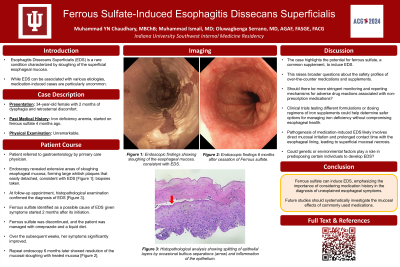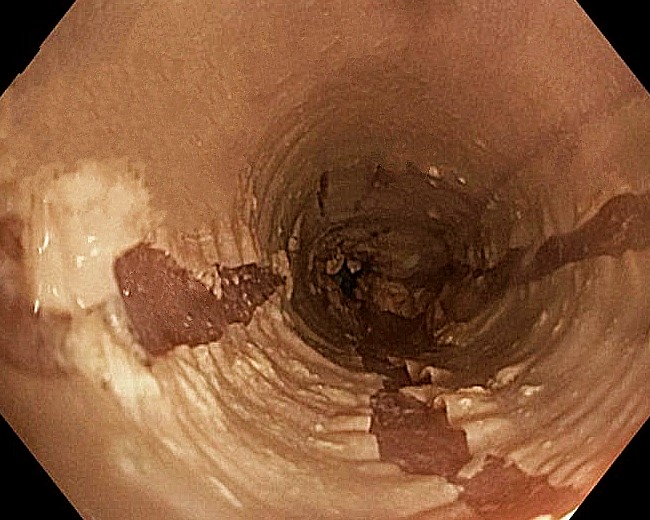Tuesday Poster Session
Category: Esophagus
P4019 - Ferrous Sulfate-Induced Esophagitis Dissecans Superficialis: A Case Report
Tuesday, October 29, 2024
10:30 AM - 4:00 PM ET
Location: Exhibit Hall E

Has Audio

Muhammad YN Chaudhary, MBChB
Indiana University Southwest
Evansville, IN
Presenting Author(s)
Muhammad YN. Chaudhary, MBChB1, Muhammad Ismail, MD2, Oluwagbenga Serrano, MD, FACG3
1Indiana University Southwest, Evansville, IN; 2Indiana University Southwest, Cedar Rapids, IA; 3Good Samaritan Hospital, Vincennes, IN
Introduction: Esophagitis Dissecans Superficialis (EDS) is a rare esophageal disorder characterized by sloughing of the superficial mucosa. While EDS can be associated with various etiologies, medication-induced cases are particularly uncommon. This case report details a novel instance of EDS induced by ferrous sulfate, aiming to enrich the medical literature and provide clinicians with insights into the diagnosis and management of this rare condition.
Case Description/Methods: A 34-year-old female with a history pertinent only for iron deficiency anemia presented with dysphagia and retrosternal discomfort. Her medication consisted only of ferrous sulfate, which she had been taking for several months. Due to persistent symptoms, an esophagogastroduodenoscopy (EGD) was performed.
The EGD revealed extensive areas of sloughing esophageal mucosa, forming large whitish plaques that easily detached, consistent with EDS (Image 1). The esophageal mucosa underneath appeared erythematous but not ulcerated. Biopsies were taken, confirming the diagnosis of EDS without evidence of malignancy or infectious etiology.
Given the temporal relationship between the onset of symptoms and the initiation of ferrous sulfate, the supplement was identified as the likely cause. Ferrous sulfate was discontinued, and the patient was managed with omeprazole and a liquid diet. Over the subsequent weeks, her symptoms significantly improved, and a follow-up EGD showed resolution of the mucosal sloughing with healed mucosa.
Discussion: EDS is a condition that can often be misdiagnosed due to its rarity and non-specific presentation. The unique aspect of this case is the clear association between ferrous sulfate and EDS, an association not well-documented in current medical literature.
The pathogenesis of medication-induced EDS likely involves direct mucosal irritation and prolonged contact time with the esophageal lining, leading to superficial mucosal necrosis. Clinicians should consider medication history, especially iron supplements, when encountering unexplained esophageal symptoms and mucosal abnormalities on EGD.
This case underscores the importance of thorough patient history and careful interpretation of endoscopic findings. Awareness of such rare adverse effects can guide appropriate management, including the discontinuation of the offending agent and supportive care with proton pump inhibitors and dietary modifications.

Disclosures:
Muhammad YN. Chaudhary, MBChB1, Muhammad Ismail, MD2, Oluwagbenga Serrano, MD, FACG3. P4019 - Ferrous Sulfate-Induced Esophagitis Dissecans Superficialis: A Case Report, ACG 2024 Annual Scientific Meeting Abstracts. Philadelphia, PA: American College of Gastroenterology.
1Indiana University Southwest, Evansville, IN; 2Indiana University Southwest, Cedar Rapids, IA; 3Good Samaritan Hospital, Vincennes, IN
Introduction: Esophagitis Dissecans Superficialis (EDS) is a rare esophageal disorder characterized by sloughing of the superficial mucosa. While EDS can be associated with various etiologies, medication-induced cases are particularly uncommon. This case report details a novel instance of EDS induced by ferrous sulfate, aiming to enrich the medical literature and provide clinicians with insights into the diagnosis and management of this rare condition.
Case Description/Methods: A 34-year-old female with a history pertinent only for iron deficiency anemia presented with dysphagia and retrosternal discomfort. Her medication consisted only of ferrous sulfate, which she had been taking for several months. Due to persistent symptoms, an esophagogastroduodenoscopy (EGD) was performed.
The EGD revealed extensive areas of sloughing esophageal mucosa, forming large whitish plaques that easily detached, consistent with EDS (Image 1). The esophageal mucosa underneath appeared erythematous but not ulcerated. Biopsies were taken, confirming the diagnosis of EDS without evidence of malignancy or infectious etiology.
Given the temporal relationship between the onset of symptoms and the initiation of ferrous sulfate, the supplement was identified as the likely cause. Ferrous sulfate was discontinued, and the patient was managed with omeprazole and a liquid diet. Over the subsequent weeks, her symptoms significantly improved, and a follow-up EGD showed resolution of the mucosal sloughing with healed mucosa.
Discussion: EDS is a condition that can often be misdiagnosed due to its rarity and non-specific presentation. The unique aspect of this case is the clear association between ferrous sulfate and EDS, an association not well-documented in current medical literature.
The pathogenesis of medication-induced EDS likely involves direct mucosal irritation and prolonged contact time with the esophageal lining, leading to superficial mucosal necrosis. Clinicians should consider medication history, especially iron supplements, when encountering unexplained esophageal symptoms and mucosal abnormalities on EGD.
This case underscores the importance of thorough patient history and careful interpretation of endoscopic findings. Awareness of such rare adverse effects can guide appropriate management, including the discontinuation of the offending agent and supportive care with proton pump inhibitors and dietary modifications.

Figure: Image 1: Esophagitis Dissecans Superficialis. Sloughing of the superficial mucosa.
Disclosures:
Muhammad Chaudhary indicated no relevant financial relationships.
Muhammad Ismail indicated no relevant financial relationships.
Oluwagbenga Serrano: MERCK – Stock-publicly held company(excluding mutual/index funds).
Muhammad YN. Chaudhary, MBChB1, Muhammad Ismail, MD2, Oluwagbenga Serrano, MD, FACG3. P4019 - Ferrous Sulfate-Induced Esophagitis Dissecans Superficialis: A Case Report, ACG 2024 Annual Scientific Meeting Abstracts. Philadelphia, PA: American College of Gastroenterology.
